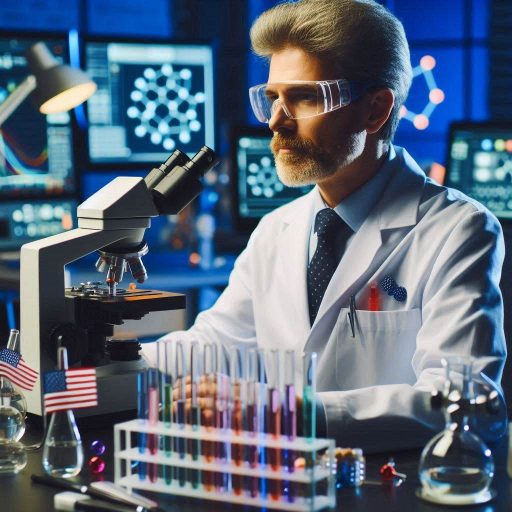Introduction
Nanotechnology involves manipulating materials at the nanoscale, typically between 1 and 100 nanometers.
This innovative field plays a crucial role in various industries, including healthcare, electronics, and environmental science.
By creating materials with unique properties, nanotechnology drives innovation and enhances product performance.
For instance, in medicine, nanotechnology enables targeted drug delivery systems that can significantly improve patient outcomes.
In electronics, nanoscale materials contribute to faster, smaller, and more efficient devices.
Understanding the work environment and conditions of nanotechnologists is essential for several reasons.
Their jobs often require working in laboratories and cleanroom settings, where adherence to strict safety protocols is critical.
These specialized environments necessitate the use of advanced equipment and protective gear to minimize exposure to potentially hazardous materials.
Nanotechnologists must often handle chemicals and particles that could pose health risks if not managed properly.
Studying the work conditions of nanotechnologists can highlight the challenges they face daily.
These challenges may include long hours, high-pressure projects, and the need for constant attention to detail.
Additionally, research into their work environment can inform best practices for safety and efficiency.
Organizations that prioritize the health and well-being of their employees often see improved job satisfaction and productivity.
Nanotechnologist job description
Definition of Nanotechnology and Nanotechnologist
Nanotechnology involves manipulating matter at the nanoscale, which is about 1 to 100 nanometers.
This technology enables the development of new materials and devices with unique properties.
A nanotechnologist specializes in this field, applying scientific principles to create innovative solutions.
They work across various industries, including medicine, electronics, and environmental science.
Nanotechnologists play a crucial role in advancing technology and improving product performance.
Responsibilities of a Nanotechnologist
The responsibilities of a nanotechnologist vary based on their specific role and industry.
They conduct experiments to develop new nanomaterials and analyze their properties.
This process involves designing experiments, collecting data, and interpreting results.
Nanotechnologists also collaborate with multidisciplinary teams to integrate nanotechnology into existing products.
In addition to research, nanotechnologists often engage in product development.
They help design nanotechnology-based products and improve manufacturing processes.
Quality control is another critical aspect of their role.
Nanotechnologists ensure that materials meet required specifications and safety standards.
Furthermore, they may be involved in educating others about nanotechnology applications.
This includes presenting findings to stakeholders and writing technical reports.
Nanotechnologists must stay updated on industry trends and advancements to remain competitive.
Continuous learning is vital in this rapidly evolving field.
Importance of Understanding Work Environment for Career Success
Understanding the work environment is essential for a successful career as a nanotechnologist.
Different settings, such as laboratories, research institutions, and manufacturing facilities, present unique challenges.
Each environment has specific safety protocols, equipment, and regulatory requirements.
A laboratory setting often requires strict adherence to safety guidelines.
Nanotechnologists must wear appropriate personal protective equipment (PPE) to prevent exposure to hazardous materials.
Familiarity with laboratory protocols enhances safety and efficiency.
In research institutions, collaboration and communication are vital.
Nanotechnologists often work in teams, sharing ideas and expertise.
Understanding the dynamics of teamwork fosters a positive work atmosphere.
Manufacturing environments focus on production efficiency and quality control.
Nanotechnologists need to adapt to fast-paced conditions while maintaining precision.
Recognizing the demands of this environment helps professionals thrive.
Moreover, understanding the organizational culture is crucial.
Each workplace has its own values and expectations.
Adapting to these norms can lead to better job satisfaction and career advancement.
Basically, nanotechnology is a field that holds significant promise for innovation.
A nanotechnologist’s responsibilities range from research to product development.
Understanding the work environment enhances career success and helps professionals navigate challenges effectively.
By recognizing the importance of their surroundings, nanotechnologists can thrive in their careers and contribute to technological advancements.
Read: Interdisciplinary Research: Botany and Other Sciences
Work Environment of a Nanotechnologist
Overview of Typical Work Settings for Nanotechnologists
Nanotechnologists typically work in several settings.
Research labs in universities focus on developing new materials and technologies.
Here, they conduct experiments to explore the properties of nanomaterials.
Research centers, both public and private, often focus on applied nanotechnology.
These centers aim to develop commercial products or improve existing technologies.
Industry facilities also host nanotechnologists.
In these environments, professionals work on product development and quality control.
For example, nanotechnologists in the electronics sector develop advanced components for devices.
Others work in the pharmaceutical industry, creating innovative drug delivery systems.
Additionally, government laboratories conduct significant nanotechnology research.
These facilities often collaborate with academic and industry partners.
Such partnerships foster innovation and accelerate the development of new applications.
Importance of Controlled Environments for Nanotechnology Research
Controlled environments are crucial for nanotechnology research.
Nanomaterials have unique properties that require precise conditions for effective study.
Researchers must control temperature, humidity, and contamination levels.
A stable environment ensures that experiments yield accurate and reproducible results.
Cleanrooms are often essential in nanotechnology labs.
These specialized facilities minimize contamination from dust, airborne particles, and chemical vapors.
By maintaining strict cleanliness standards, researchers can better understand the behavior of nanomaterials.
This attention to detail ultimately leads to more reliable research outcomes.
Potential Hazards and Safety Measures in Nanotechnology Labs
Despite their potential, nanotechnology labs pose specific hazards.
Nanoparticles can be toxic or reactive, presenting health risks to researchers.
Inhalation, skin contact, and ingestion are potential exposure routes.
Therefore, labs must implement strict safety protocols to protect workers.
Personal protective equipment (PPE) is vital in these settings.
Nanotechnologists should wear gloves, lab coats, and masks to minimize exposure.
Additionally, proper ventilation systems help reduce airborne particles, ensuring a safer environment.
Labs should also have clear signage to warn personnel about specific hazards.
Furthermore, training programs on handling nanomaterials are essential.
Researchers must understand the properties and risks associated with the substances they work with.
Regular safety drills and evaluations can help maintain a culture of safety in the workplace.
Therefore, nanotechnologists work in diverse environments, including labs, research centers, and industry facilities.
Controlled environments are vital for ensuring accurate research outcomes.
However, potential hazards associated with nanomaterials necessitate strict safety measures.
By fostering safe work conditions, nanotechnologists can continue to innovate while protecting their health and well-being.
Understanding these aspects of their work environment is essential for appreciating the complexities of nanotechnology.
Read: How Climate Change Is Impacting Plant Research
Conditions of work for nanotechnologists
Discussion on Work Hours and Flexibility in the Field
Nanotechnologists often work in diverse environments, including laboratories, offices, and industrial settings.
Their work hours can vary significantly depending on the project.
Many nanotechnologists enjoy flexible schedules that allow them to balance work and personal life.
Some may work traditional hours, while others opt for irregular hours based on project needs.
This flexibility can enhance job satisfaction and productivity.
However, deadlines can also lead to longer hours, especially when projects approach critical phases.
Despite the variability, many find the field offers a healthy work-life balance.
Importance of Collaboration with Other Researchers and Scientists
Collaboration is crucial in the field of nanotechnology.
Nanotechnologists frequently work alongside chemists, engineers, and materials scientists.
This teamwork fosters innovation and accelerates research progress.
By sharing expertise, researchers can solve complex problems more effectively.
Collaborative projects often lead to groundbreaking discoveries that might not emerge in isolation.
Additionally, working with interdisciplinary teams broadens knowledge and skill sets.
Networking with other professionals in the field can lead to exciting opportunities and partnerships.
Strong communication skills are essential for successful collaboration in this dynamic environment.
Impact of Work Conditions on Research Outcomes and Advancements in Nanotechnology
Work conditions significantly impact research outcomes in nanotechnology.
Access to state-of-the-art facilities and equipment enhances productivity and creativity.
Well-designed laboratories provide a safe space for experimentation, which is critical in this field.
Proper ventilation, clean rooms, and safety measures protect researchers from potential hazards.
Furthermore, supportive management can foster a positive work culture.
This environment encourages innovation and risk-taking, leading to advancements in research.
Inadequate work conditions can hinder progress.
Insufficient resources or outdated equipment may slow down experiments and limit researchers’ capabilities.
Stressful environments can also affect morale and motivation.
Researchers who feel supported are more likely to produce high-quality work.
Therefore, organizations must prioritize creating conducive work environments.
Furthermore, advancements in nanotechnology often stem from the interaction between various disciplines.
New materials and techniques arise from combining ideas across fields.
For instance, collaboration between nanotechnologists and biologists can lead to innovative medical applications.
Such partnerships are essential for tackling complex challenges and pushing boundaries in research.
Read: Women in Botany: Celebrating Pioneers and Leaders

Physical and Mental Demands
Overview of the Physical Demands of Working in a Nanotechnology Lab
Working in a nanotechnology lab presents unique physical demands.
Researchers often spend long hours standing while conducting experiments.
This extended period can lead to fatigue if not managed properly.
Precision work is crucial in nanotechnology, requiring careful attention to detail.
Scientists handle tiny materials that can only be seen with specialized equipment.
Consequently, they must maintain a steady hand and keen eyesight.
The lab environment often requires wearing protective gear, such as gloves and goggles.
These items can sometimes feel restrictive, adding to the physical demands.
Equipment used in nanotechnology can be heavy and cumbersome, further straining researchers.
Safety protocols also necessitate frequent movement around the lab, which can lead to physical exhaustion.
To counteract these challenges, it is essential for nanotechnologists to practice good ergonomics.
Regular breaks can help alleviate physical strain and refresh focus.
Importance of Mental Resilience and Focus in Dealing with Complex Research Projects
In addition to physical demands, mental resilience is vital in nanotechnology.
Researchers frequently tackle complex problems that require innovative solutions.
This work can be mentally taxing, often leading to frustration and stress.
Thus, maintaining focus is crucial for success in this field.
Distractions can derail experiments and prolong project timelines.
Developing strong mental resilience helps researchers navigate setbacks effectively.
Nanotechnologists must remain adaptable to evolving project requirements.
New findings can shift the direction of research unexpectedly.
This need for flexibility can be challenging but is essential for progress.
Engaging in mindfulness practices, such as meditation or deep-breathing exercises, can enhance focus.
These practices help clear the mind, allowing for better concentration on tasks.
Strategies for Maintaining Work-Life Balance in a Demanding Field
Maintaining a work-life balance in the demanding field of nanotechnology is essential.
Long hours and intense focus can easily lead to burnout.
To combat this, researchers should prioritize setting boundaries.
Allocating specific times for work and personal activities helps create structure.
Utilizing tools like calendars or task management apps can facilitate this process.
Additionally, fostering strong social connections can improve overall well-being.
Engaging with colleagues and friends provides essential support outside the lab.
Taking time for hobbies and relaxation can rejuvenate the mind and body.
Regular physical activity also contributes to a balanced lifestyle.
Exercise promotes mental clarity and reduces stress levels.
In general, the work environment for nanotechnologists is both physically and mentally demanding.
Understanding the physical requirements, cultivating mental resilience, and maintaining work-life balance are crucial for success.
By adopting effective strategies, researchers can thrive in this dynamic field.
Balancing these demands not only enhances productivity but also ensures a healthier, more fulfilling career.
As the field continues to evolve, embracing these practices will become increasingly important for long-term success.
Read: Exploring the Different Branches of Geology
Learn More: Restoration Ecology: How Botanists Revive Ecosystems
Technology and Equipment
Discussion on the advanced technology and equipment used by nanotechnologists
Nanotechnologists operate in a highly specialized work environment that leverages advanced technology and equipment.
Their work often requires unique tools designed to manipulate materials at the nanoscale.
These professionals utilize advanced microscopes, such as atomic force microscopes and scanning electron microscopes.
These tools allow them to visualize and analyze materials at unprecedented resolutions.
Nanotechnologists also employ techniques like lithography and chemical vapor deposition.
These methods enable the precise fabrication of nanostructures.
Lithography involves transferring patterns onto materials, while chemical vapor deposition helps in layering thin films.
Mastering these techniques is crucial for developing new nanomaterials and products.
Transform Your Career Today
Unlock a personalized career strategy that drives real results. Get tailored advice and a roadmap designed just for you.
Start NowImportance of Training and Proficiency in Handling Specialized Tools
Training and proficiency are vital for nanotechnologists.
These professionals must understand how to operate specialized equipment safely and effectively.
Proper training ensures they can produce reliable results while minimizing risks.
Many institutions offer programs focused on nanotechnology, providing essential knowledge about materials and processes.
Moreover, nanotechnologists need to keep up with evolving technologies.
Continuous education and hands-on experience are necessary to stay proficient.
They often attend workshops, seminars, and conferences to learn about the latest advancements.
This commitment to learning helps them adapt to new tools and techniques, enhancing their skill set.
Additionally, teamwork is essential in a nanotechnology setting.
Nanotechnologists often collaborate with chemists, physicists, and engineers.
Effective communication and cooperation are crucial for achieving project goals.
Understanding the strengths of various team members leads to better problem-solving and innovation.
Impact of Technology on Work Environment and Job Performance
The impact of technology on the work environment of nanotechnologists is profound.
Advanced tools improve job performance by enabling more precise measurements and analyses.
These enhancements lead to faster research and development cycles, allowing for quicker innovation.
As a result, organizations can bring new products to market more efficiently.
Moreover, a modern work environment incorporates automated systems for data collection and analysis.
These systems reduce the likelihood of human error and streamline workflows.
Nanotechnologists spend less time on routine tasks and can focus on creative problem-solving.
However, the reliance on advanced technology also presents challenges.
The complexity of specialized tools can lead to frustration if users lack adequate training.
Ensuring that all team members are proficient in using technology is vital.
Regular training sessions can help maintain a high level of expertise across the team.
In review, nanotechnologists work in a dynamic environment that requires specialized equipment and advanced techniques.
Training and proficiency in handling these tools are essential for success.
The integration of technology significantly impacts job performance, leading to increased efficiency and innovation.
As the field of nanotechnology continues to evolve, professionals must stay informed and adaptable to maintain their competitive edge.
Embracing these advancements will foster a productive work environment and drive future breakthroughs in nanotechnology.
Regulatory compliance and ethical considerations
Importance of Following Regulations and Guidelines in Nanotechnology Research
Nanotechnologists work in a rapidly evolving field.
They must adhere to strict regulations and guidelines to ensure safety and effectiveness.
These regulations protect researchers, consumers, and the environment from potential risks associated with nanomaterials.
Compliance with established guidelines fosters a culture of safety within research laboratories and industrial settings.
Following these rules also promotes the responsible use of nanotechnology in various applications.
Government agencies and international organizations set these regulations.
They provide frameworks that guide researchers in conducting their work responsibly.
Understanding these guidelines is crucial for nanotechnologists to avoid legal issues and ensure project success.
Regulations help standardize practices across the industry, ensuring quality and reliability in nanotechnology research and product development.
Ethical Considerations in Using Nanotechnology for Research and Product Development
Ethical considerations play a significant role in nanotechnology.
Researchers must evaluate the potential impacts of their work on society and the environment.
These considerations include assessing risks associated with nanomaterials and their applications.
Nanotechnologists should prioritize public health and safety when developing new products.
They must also consider the long-term implications of their research on various communities.
Moreover, ethical dilemmas may arise regarding the use of nanotechnology in consumer products.
Transparency in communication about the benefits and risks of nanomaterials is vital.
Researchers must engage with the public and stakeholders to address concerns effectively.
This engagement fosters trust and ensures that ethical practices guide the development and application of nanotechnology.
Impact of Regulatory Compliance and Ethical Decisions on Work Environment and Career Progression
Regulatory compliance and ethical decisions significantly impact the work environment for nanotechnologists.
A strong commitment to following guidelines creates a safer, more productive laboratory atmosphere.
Researchers feel empowered to share their concerns and ideas when regulations are in place.
This openness fosters collaboration and innovation, essential for advancing nanotechnology.
Moreover, ethical decision-making can enhance career progression for nanotechnologists.
Professionals known for their integrity and commitment to ethical practices are more likely to earn respect and recognition.
Employers value individuals who prioritize compliance and ethical considerations in their work.
As a result, these professionals may have greater opportunities for advancement within their organizations.
In essence, following regulations and guidelines is crucial in nanotechnology research.
Ethical considerations ensure responsible use and development of nanomaterials.
The interplay between compliance, ethics, and work environment influences career progression.
Nanotechnologists must prioritize these aspects to contribute positively to the field while ensuring safety and sustainability.
By embracing these principles, they can foster innovation and build a successful career in this dynamic discipline.
Discover More: Data Scientist: Skills Needed to Succeed in 2024
Conclusion
Understanding the work environment and conditions for nanotechnologists is crucial for achieving career success and advancement.
Nanotechnologists typically operate in diverse settings, including laboratories, research facilities, and industrial environments.
Each of these locations emphasizes safety and precision due to the nature of their work, which often involves handling advanced materials and complex equipment.
Collaboration with interdisciplinary teams is a significant aspect of the job.
By working alongside chemists, physicists, and engineers, nanotechnologists enhance innovation and improve problem-solving capabilities.
Such teamwork fosters a rich exchange of ideas, which is essential for breakthroughs in the field.
Nanotechnologists face unique challenges, such as the need for specialized equipment and strict adherence to safety protocols.
Continuous learning about the latest technologies and industry trends is essential for staying competitive and advancing in one‘s career.
Networking with professionals in the field can also open doors to new opportunities and insights that are vital for professional growth.
Knowledge of workplace conditions also helps aspiring nanotechnologists prepare for potential challenges.
Understanding safety regulations and compliance standards is crucial, as they play a significant role in ensuring a safe working environment.
By being aware of these factors, individuals can navigate their careers more effectively.
[E-Books for Sale]
The Big Book of 500 High-Paying Jobs in America: Unlock Your Earning Potential
$19.99 • 500 High-Paying Jobs • 330 pages
Explore 500 high-paying jobs in America and learn how to boost your career, earn more, and achieve success!
See All 500 High-Paying Jobs of this E-Book
1001 Professions Without a Degree: High-Paying American Jobs You Can Start Now
$19.99 • 1001 Professions Without a Degree • 174 pages
Discover 1001 high-paying jobs without a degree! Unlock career tips, skills, and success strategies for just $19.99!




